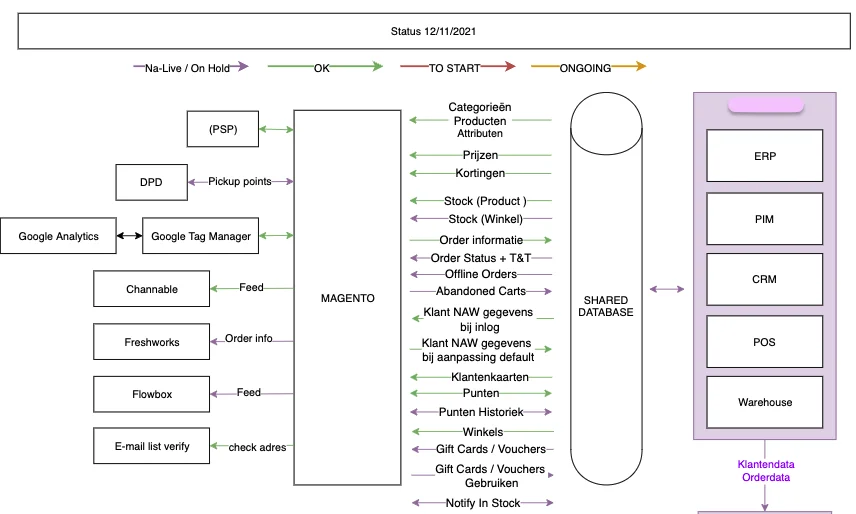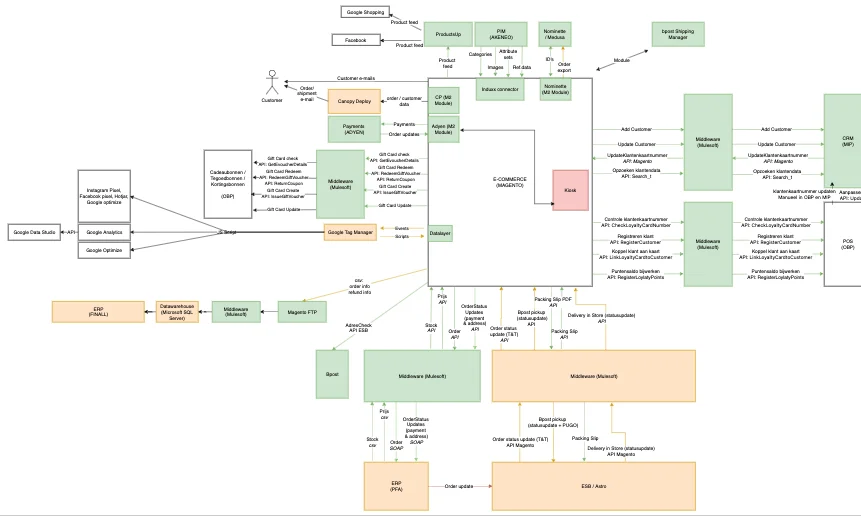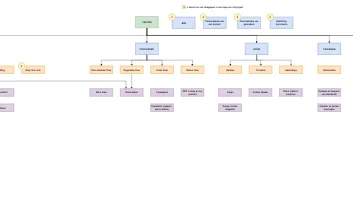

To make every project plan a digital success, PHPro worked out its own method: our PHPro Roadmap. Today we would like to explain phase 4: the technical and functional analysis.
Discovery
The first series of workshops are part of what we call the “discovery” or discovery phase. After discovery, a steerco is scheduled to discuss the deliverables of this phase. These deliverables are:



1. High-level Context Diagram
Every project requires a global overview of the components involved in your project, along with a good view of the integrations. This diagram is also the handhold for our customers and the project manager to have an overview of what information is exchanged, in what direction information is exchanged, how often information is exchanged (frequency & volume) and what functionality is targeted. Thanks to this high-level context diagram, the scope and complexity of the project is also much clearer.
Here are some examples of a high-level context diagram:




2. Work Breakdown Structure
The WBS provides a framework for the project. Here the work is divided into hierarchically definable steps in which concrete main activities are divided into logical subactivities. In this way, the work can be divided into development, schedule and cost. For the WSB workshop, the information from the pre-sales process is taken as a basis. During the workshop this is reviewed and adjusted if necessary.
The WBS also helps us monitor the scope and shape the project. Later, the WBS also ensures that it is clear to everyone within the project what has already been done and what sub-activities still need to follow to bring the project to a successful conclusion.
Below is an example of a WBS:
3. Functional Requirements Document
It is very important to get a better idea of what is needed. We always keep a good overview of all the desired features, and whether the impact is realistic within the budget. Based on this information, we get a document that gives a clear picture of the features to be implemented in the software solution.
The document contains the necessary information in the areas of
- Data manipulation
- Data processing
- Other integrations that will be performed digitally.
The document may also contain related information such as:
- Performance requirements
- Security details
- Constraints within which the platform must operate.
In addition to functional requirements, non-functional requirements can also be included in this document. These include UX, performance and maintenance requirements.
In an ideal world, user stories are created as early as the discovery phase and incorporated into the Functional Requirements Document. This gives the stakeholders a detailed description of the tasks a user can do with the software solution and provides more clarity and direction for the stakeholder(s). Typically, user stories are (further) developed after the discovery phase.
Sometimes sketches and wireframes can also be included in the document. These can help to outline UI design requirements during analysis & design, specify navigation logic and how screens will be linked together.
4. Budget estimate
The budget estimate is created (again) based on the data in the Functional Requirements Document. The budget proposal is broken down into epics: these are individual components that are critical to both the stakeholders and the team responsible for design and development. An overall cost proposal gives the stakeholders an idea of how much investment is needed during the time it takes to build, test and install the platform. The discovery phase makes it possible to deliver a budget proposal with more accurate estimates.
5. High-level project plan
The high-level project plan maps out the scope of the project with the budget and timeline. It is usually management-oriented: project managers and stakeholders provide the information within the high-level project plan. This plan lists who the project's stakeholders are, what the purpose of the project is, what is the status of budgets, when the project would be ready (roadmap), what are the risks, ....
Together, these documents ensure that 80-90% of the scope of the project is fixed, in other words, the big picture is clear(er)!
Functional Analysis
While building a good picture of what our application will look like and especially what the requirements are, we look at how this can be implemented and where the technical difficulties lie. In the technical and functional analysis (which usually runs parallel to wireframing and design), the desired features are mapped out, analyzed in depth and checked off against the current setup, integrations, tools, plugins and APIs. In this way, in consultation with the client and based on our functional and technical knowledge of the platform, combined with budget and planning, the scope of the project is determined.
Based on this analysis, we make a more concrete budget estimate and development can start.
The various workshops are defined during the kick-off meeting, and depending on the people who need to attend each topic, the agenda is determined. Broadly speaking, according to topics are usually discussed, of course strongly dependent on the business case:
- Architecture, integrations & basic design
- High level architecture
- Magento setup
- Integrations
- Information architecture
- Product types - Basic pages
- Header, footer & navigation menu
- Homepage
- Product model
- Category page
- Product detail page - visual
- Shopping cart
- Checkout
- Search & search results
- Store blog
- Find a store
- My Account - B2B
- Company Structure
- Shared catalog
- Pricing
- Price quotations - Product data
- Master data
- Stock
- Pricing
- Taxes - Checkout
- Shipment
- Payment
- Order flow
- Invoicing
- Return & RMA - Search, CMS
- Search configuration for advanced search
- CMS
- Basic / Advanced CMS Features
- FAQ, About Us, ... - SEO, Legal & Reporting
- Technical SEO & keyword research
- Reporting, tracking & dashboarding
- Legal: GDPR, cookie consent, privacy policy, ... - Other
- Performance
- Gifts
- ...
What can you expect?
The end result of this phase is a document with an exact description of the platform to be developed.
The elaboration of this document is done in Confluence, so it can be followed and consulted online at any time.
After approval of this analysis document, a new estimate can be made for the following phases.
Turn your project plan into a digital success!
Do you have a digital project you want to make a success of? Do you also believe in a proven project approach as a solid foundation for a successful project? Then be sure to contact us!